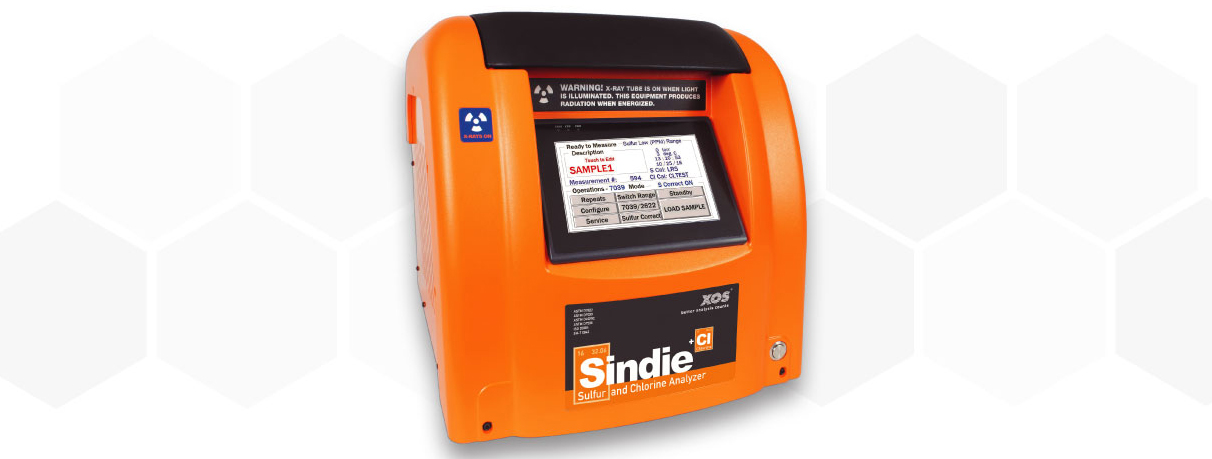- Analyzers
- Optics & Sources
- Technologies
- Support
- About
Precision Comparison Between ASTM Test Methods D7039, D2622, and D5453
BACKGROUND
For many years, professionals in the petroleum industry have faced challenges regarding compliance and quality of product. These challenges are made more difficult by the variety of regulations and specifications, and the implications they present for their refining process. Regulators across the globe are moving to even more restrictive regulations on sulfur content in a variety of fuels with many countries now requiring maximum sulfur concentration in automotive fuels of 10 to 15 parts per million (ppm).
These regulations have furthered the need for refineries to maximize the precision of their sulfur analysis methodology. Desulfurization processes are expensive utilizing catalyst, hydrogen, and heat. By using a more precise sulfur measurement technique, refiners can produce product closer to the specification maximums, reducing giveaway and saving money. This savings is illustrated in Figure 1. In addition to production efficiencies, refiners can avoid inaccurate reporting which can lead to regulatory missteps and contract disputes by using a test method with better precision.
With several different methodology options for sulfur analysis available, refineries, terminals, and test inspection certification companies must take care to select a method that produces the least amount of variability in their measurements.
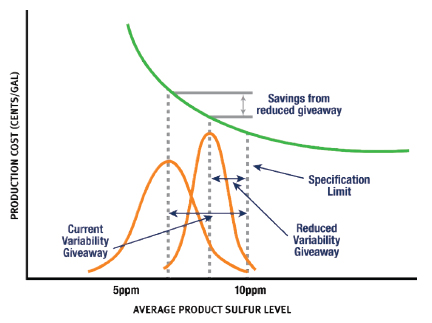
Figure 1: Savings From Improved Measurement Precision
ASTM conducts Proficiency Testing Programs (PTP) several times per year. In each PTP study, ASTM sends samples of hydrocarbon products or feedstocks to various participant sites. Each participating laboratory performs analyses following ASTM methods for various test parameters, including sulfur, using the samples provided. This paper will discuss the ASTM PTP sulfur results for Reformulated Gasoline (RFG) and Ultra Low Sulfur Diesel (ULSD) programs from 2015-2017 using the most common test methods for low sulfur automotive fuels: D7039, D2622, and D5453. First, an understanding of the test methods is critical to interpreting the data presented.
ASTM Method D7039 (Monochromatic Wavelength Dispersive X-Ray Fluorescence)
Monochromatic Wavelength Dispersive X-ray Fluorescence (MWDXRF) is a subset of WDXRF that utilizes similar principles. Rather than using filters or traditional crystals that are flat or singly curved, MWDXRF incorporates doubly curved crystal (DCC) optics to provide a focused, monochromatic excitation X-ray beam to excite the sample. A second DCC optic is used to collect the sulfur signal and focus it onto the detector. This modified methodology delivers a signal-to-background ratio that is 10-times more precise than traditional WDXRF, which improves method precision and Limit of Detection (LOD).
MWDXRF Diagram
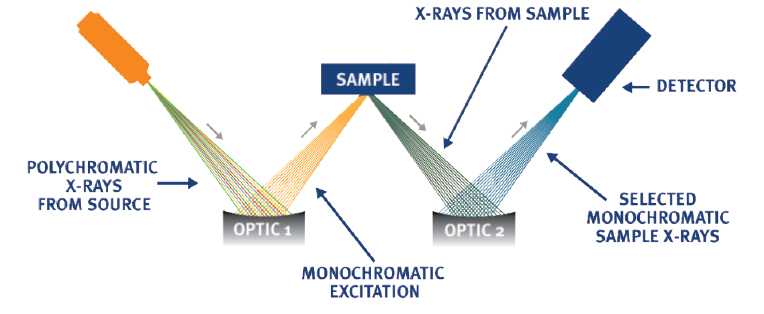
ASTM Method D2622 (Wavelength Dispersive X-ray Fluorescence)
Wavelength Dispersive X-ray Fluorescence (WDXRF) is a type of X-ray Fluorescence, or XRF, which uses high-intensity X-rays to excite elements of interest within a sample. Upon exposure, fluorescent X-rays are emitted from the sample at energy levels that are unique to each element. Additionally, the background signal, an energy region not characteristic of sulfur or other interfering elements, is collected and subtracted from the sulfur signal to improve precision and LOD. To isolate the sulfur signal and to reduce noise, WDXRF utilizes a filter and a collection crystal before the sulfur signal reaches the detector. WDXRF also differs from MWDXRF in that it doesn’t specify excitation type (i.e. monochromatic OR polychromatic excitation), whereas MWDXRF specifies monochromatic excitation.
ASTM Method D5453 (Ultraviolet Fluorescence)
In Ultraviolet Fluorescence (UVF) technology, a hydrocarbon sample is either directly injected into a high temperature (1000°C) combustion furnace or placed in a sample boat that is cooled and then injected into the combustion furnace. The sample is combusted in the tube, and sulfur is oxidized to sulfur dioxide (SO2) in the oxygen-rich atmosphere. Water produced during the sample combustion is removed by a membrane dryer and the sample combustion gasses are exposed to ultraviolet (UV) light. SO2 is excited (SO2*), and the resulting fluorescence that is emitted from the SO2* as it returns to the stable state is detected by a photomultiplier tube. The resulting signal is a measure of the sulfur contained in the sample.
PRECISION & ILS RESULTS
Hundreds of participants are involved in the monthly ULSD PTP program, which exclusively looks at sulfur. The monthly RFG PTP boasts over a hundred participants running a variety of test methods for differing RFG parameters. The data shown represents sulfur data collected throughout the study from January 2015 to December 2017.
Understanding the Data (Mean Concentration and Reproducibility)
Both graphs and tables shown below track average sample concentration and reproducibility (R). Reproducibility is the difference between two single and independent results obtained by different operators applying the same test method in different laboratories using different apparatus on identical test material. A lower reproducibility value correlates to a better level of precision which can minimize risks from inaccurate reporting such as regulatory fines and contract disputes.
The data presented is filtered to show all samples whose average concentration ranged between 5 and 15 ppm. These values were chosen based on the most common regulatory requirements for sulfur content in automotive fuel in Europe, United States, China, and others around the world. It is critical for an analyzer to have low reproducibility values (better precision) when measuring these types of samples. When interpreting the data, keep in mind:
Graphs 1 & 2
- Both graphs are sorted by decreasing sample mean.
- Each column cluster in the graphs represents reproducibility for one sample measured by multiple laboratories each using D7039, D2622, or D5453.
- Within each column cluster, each color-coded bar corresponds to reproducibility for one test method. D7039 is in orange, D2622 is in gray, and D5453 is in blue.
- The numerical value of each method/bar is graphed on the left axis. (remember - lower R values are indicative of better precision).
- For many test methods, precision is often dependent on concentration. For context, the monthly average sulfur concentration is graphed as a red dot and its value is shown on the right axis of the graphs.
Tables 1 & 2
- Both tables are sorted by decreasing sample mean.
- Both tables are color-coded to indicate relative monthly performance; green represents the best method reproducibility, yellow represents the second best reproducibility, and red represents the poorest reproducibility.
The average R value across the 3 years of study data is the key performance indicator shown in both graphs and tables. A summary of the reproducibility of the RFG and ULSD PTP samples for 2015 - 2017 showed that ASTM D7039, using MWDXRF, had:
- The best precision for RFG 100% of the time compared to D2622
- The best precision for RFG 91% of the time compared to D5453
- The best precision for ULSD 89% of the time compared to D2622
- The best precision for ULSD 67% of the time compared to D5453
It is important to note that while the D7039 method had the best reproducibility in the PTP data, it is possible to utilize an instrument that complies with D2622 methods while obtaining the level of performance of D7039 technology. Those looking to meet D2622 compliance with D7039 precision can use XOS' Sindie 2622 analyzer which uses the same monochromatic excitation of D7039 analyzers while still meeting the D2622 methodology.
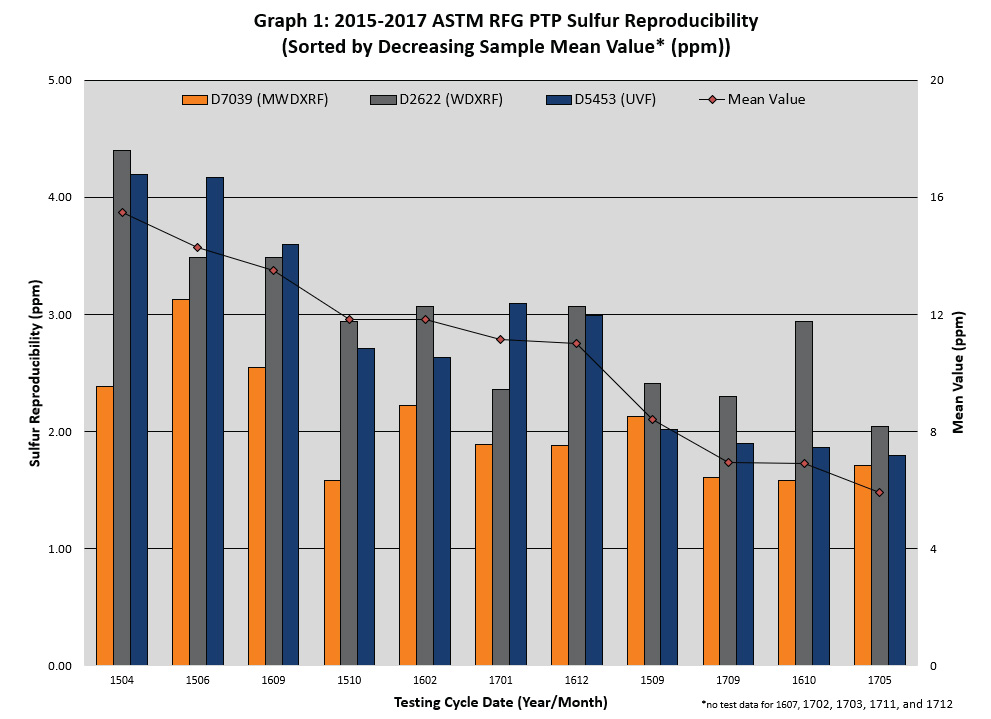
In the RFG PTP program, D7039 outperforms D2622 100% of the time, and outperforms D5453 91% of the time when evaluating samples with a mean sample concentration of 5 – 15 ppm.
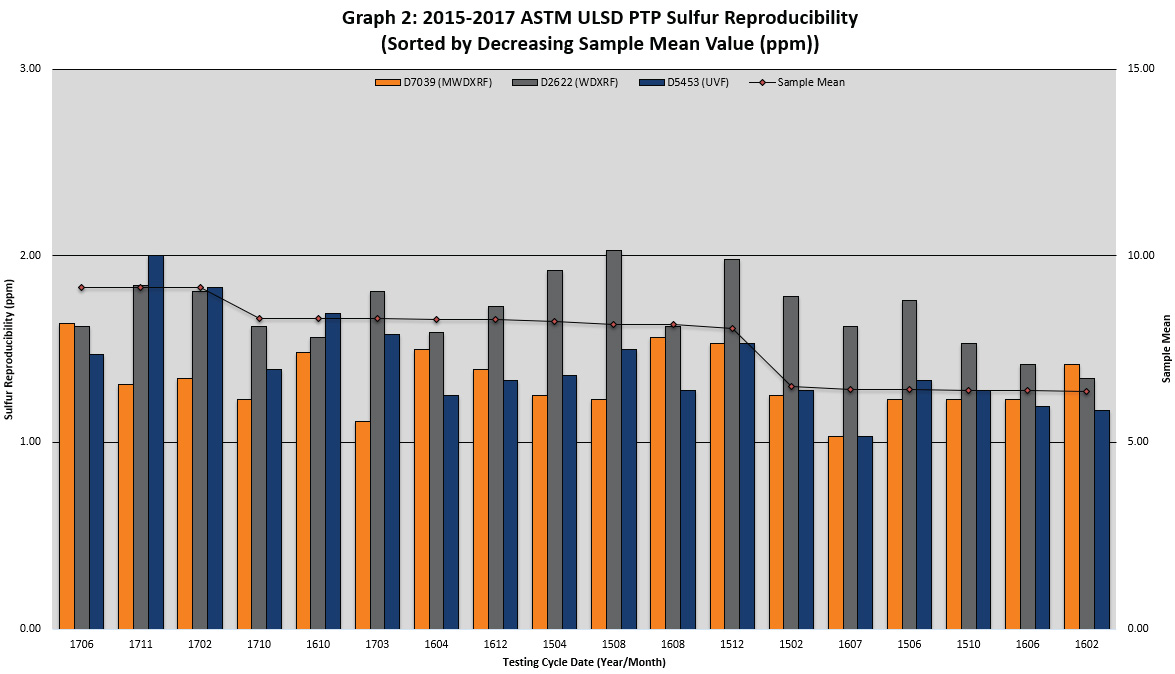
In the ULSD PTP Program, D7039 outperforms D2622 89% of the time, and is equal to or better than D5453 67% of the time when evaluating samples with a mean sample concentration of 5 - 15 ppm.
Table 1: RFG PTP Sulfur Reproducibility (5 – 15 ppm samples sorted by decreasing sample mean)
| ASTM RFG Proficiency Test Program Sulfur Reproducibility |
||||
|---|---|---|---|---|
| Reproducibility (ppm) | ||||
| Date | Sample Mean | ASTM D5453 | ASTM D2622 | ASTM D7039 |
| Apr-15 | 15.49 | 4.20 | 4.40 | 2.38 |
| Jun-15 | 14.29 | 4.17 | 3.49 | 3.13 |
| Sep-16 | 13.51 | 3.60 | 3.49 | 2.55 |
| Oct-15 | 11.83 | 2.71 | 2.94 | 1.58 |
| Feb-16 | 11.82 | 2.63 | 3.07 | 2.22 |
| Jan-17 | 11.13 | 3.09 | 2.36 | 1.89 |
| Dec-16 | 11.00 | 2.99 | 3.07 | 1.88 |
| Sep-15 | 8.42 | 2.02 | 2.41 | 2.13 |
| Sep-17 | 6.95 | 1.90 | 2.30 | 1.61 |
| Oct-16 | 6.90 | 1.86 | 2.94 | 1.58 |
| May-17 | 5.92 | 1.79 | 2.04 | 1.71 |
ASTM method D7039 outperforms method D5453 91% of the time, and outperforms method D2622 100% of the time.
KEY
Green = Best Reproducibility
Yellow = Second Best Reproducibility
Red = Poorest Reproducibility
Table 2: ULSD PTP Sulfur Reproducibility
(5 – 15 ppm samples sorted by decreasing sample mean)
| ASTM ULSD Proficiency Test Program Sulfur Reproducibility |
||||
|---|---|---|---|---|
| Reproducibility (ppm) | ||||
| Date | Sample Mean | ASTM D5453 | ASTM D2622 | ASTM D7039 |
| Jun-17 | 9.16 | 1.47 | 1.62 | 1.64 |
| Nov-17 | 9.15 | 2.00 | 1.84 | 1.31 |
| Feb-17 | 9.14 | 1.83 | 1.81 | 1.34 |
| Oct-17 | 8.33 | 1.39 | 1.62 | 1.23 |
| Oct-16 | 8.31 | 1.69 | 1.56 | 1.48 |
| Mar-17 | 8.31 | 1.58 | 1.81 | 1.11 |
| Apr-16 | 8.29 | 1.25 | 1.59 | 1.50 |
| Dec-16 | 8.28 | 1.33 | 1.73 | 1.39 |
| Apr-15 | 8.23 | 1.36 | 1.92 | 1.25 |
| Aug-15 | 8.17 | 1.50 | 2.03 | 1.23 |
| Aug-16 | 8.15 | 1.28 | 1.62 | 1.56 |
| Dec-15 | 8.05 | 1.53 | 1.98 | 1.53 |
| Feb-15 | 6.49 | 1.28 | 1.78 | 1.25 |
| Jul-16 | 6.42 | 1.03 | 1.62 | 1.03 |
| Jun-15 | 6.41 | 1.33 | 1.76 | 1.23 |
| Dec-15 | 6.40 | 1.28 | 1.53 | 1.23 |
| Jun-16 | 6.39 | 1.19 | 1.42 | 1.23 |
| Feb-16 | 6.36 | 1.17 | 1.34 | 1.42 |
ASTM method D7039 outperforms D2622 89% of the time, and is equal to or better than D5453 67% of the time.
In both Tables 1 and 2, test method D7039 contains most of the lower R values (marked as green) which indicates better PTP precision.
When measuring for critical elements such as sulfur, a highly precise testing method is vital. Low precision methods can lead to products being off spec which can costs refineries millions of dollars in fines, or product downgrading. Reducing variability in sulfur analysis is critical to reducing sulfur giveaway, and from the data shown, MWDXRF methods offer the highest level of precision and reliability.
CONCLUSION
For any refinery, a simple, streamlined elemental analysis process with high precision and reliability is critical to maximizing efficiency in every step of the refinement process. Whether monitoring ULSD or considering the refinery process strategy, refiners should take care when selecting the methodology for elemental analysis. With better precision as identified in the ASTM PTP data above, MWDXRF analyzers utilizing ASTM D7039 methodology offer users the most reliability when evaluating sulfur in automotive fuel.
PRODUCT HIGHLIGHTS
Monochromatic Wavelength Dispersive X-ray Fluorescence (MWDXRF)
MWDXRF utilizes leading-edge optics technology to produce highly precise monochromatic excitation. This method does not rely on combustion for analysis. With easy to operate instruments, MWDXRF analyzers provide refineries, terminals, and test inspection certification companies with an efficient, reliable, and highly accurate way to determine the sulfur and chlorine content of their products.

Sindie 2622 complies with ASTM D2622, D7039 and ISO 20884 methods, enabling complete flexibility in sulfur analysis. With no compromises in detection, performance and reliability, Sindie 2622 is the ideal sulfur analytical solution from ultra-low sulfur diesel and gasoline to heavy fuel oil and crudes. Utilizing MWDXRF technology, Sindie 2622 offers D2622 method compliance with D7039 performance.

Sindie +Cl delivers exceptional reproducibility for both sulfur and chlorine analysis with one push of a button and zero hassle. Samples are measured directly, which means it can analyze even the heaviest of hydrocarbons like crude oil or coker residuals, without the hassle of boats, injectors, furnaces, or changing detectors. Sindie +Cl complies with ASTM D2622, D7039, D7536, D4929, and SH/T 0842.

Sindie 7039 G3 delivers excellent precision with an LOD of 0.15 ppm at 300 s. This instrument uses Accucells for hassle-free sample preparation. Sindie 7039 complies with ASTM D7039 and ISO 20884.
